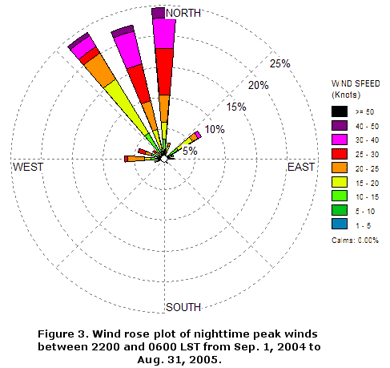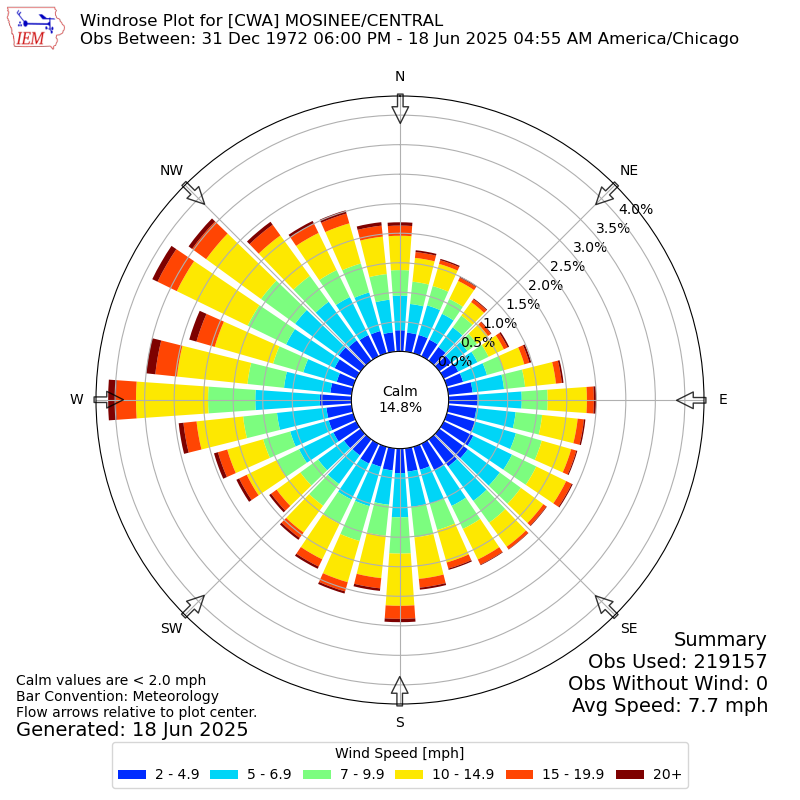

The legend at the bottom gives additional information such as the unit (km/hr), the average wind speed for the overall hours (in this case 12.8 km/hr), and percentage of time that the winds are calm (0%), and the years and month and hours of data on which each rose was constructed. Please note the legend at the bottom of the wind rose that gives the speed categories and their associated colors. Similarly, on this spoke it can be calculated that winds blow from the southeast at speeds between 7.2 and 10.8 km/hr about 3% of the time, at speeds between 10.8 and 18 km/hr about 7% of the time, between 18 and 28 km/hr about 5% of the time. Examining winds from the southeast (the longest spoke) one can determine that approximately 1% of the time the wind blows from the southeast at speeds between 3.6 and 7.2 kilometer per hour. These wind roses also provide details on speeds from different directions. This also shows that the wind rarely blows from the northwest.

This is quickly calculated by taking the sum of the frequencies of each of these directions (13+16+10=39%). In fact, the 3 spokes around the southeast direction (ESE, SE and SSE) comprise 39% of all hourly wind directions. This rose shows that the winds at Chennai during the period blow from the southeast much of the time. All wind roses shown here use 16 cardinal directions, Percentage of time that winds blow from a particular direction and at certain speed ranges. Each spoke is broken down into discrete frequency categories that show the The wind roses shown here contain additional information. It is the wind rose for Chennai, India based on three months of hourly wind data (all hours of the day). Each concentric circle represents a different frequency,Įmanating from zero at the center to increasing frequencies at the outer circles.Īn example is shown below. The length of each "spoke" around theĬircle is related to the frequency of time that the wind blows from a particular direction. Presented in a circular format, the wind rose shows the frequency of winds blowing FROM particular directions. If the color representing 30 to 35 miles (48 to 56 km) per hour moves from about halfway between the 2 circles (indicating 25 hours) to the 30 circle, then the wind spent 5 hours of time at this speed from that particular direction, as you subtract 25 from 30 hours.A wind rose gives a very concise but information-laden view of how wind speed and direction are typically distributed at a particular location.For instance, maybe the largest circle is 30 hours and the next one is 20.Instead, just look at the numbers on the wheel and subtract them as you did with the percentage. Some wind roses will have the circles already marked in days or hours so you don't have to calculate this number.DIY Guide to Fly Fishing the Lower American River in. 570 Warren Rd, Ithaca, NY 14850 Apartments - Ithaca, NY. Multiple the number of days by the percentage and then divide by 100: 16 x 14 = 224, 224 / 100 = 2.24 days. Seasonal wind rose diagrams for Rourkela City during the sampling. You noticed that the wind blew from the north at 15 to 25 miles (24 to 40 km) 14 percent of the time. For instance, say the study was over 16 days, from April 1st to April 16th.Figure out how many hours or days the study covers by adding up the time between the dates or hours given, then calculate the percentage of that time period using the percentage from the previous step. If you need to know how long the wind was at each speed, you can use the date(s) listed and the percentage you calculated from the spoke and rings to figure it out. Calculate the percentage of time the wind blew at a certain speed.


 0 kommentar(er)
0 kommentar(er)
